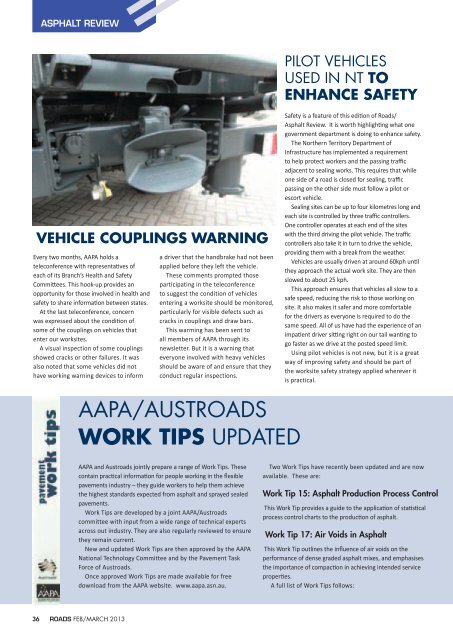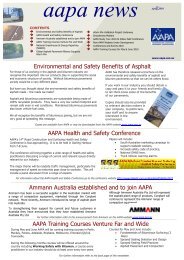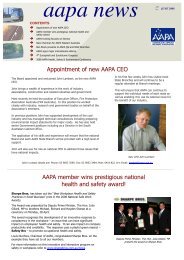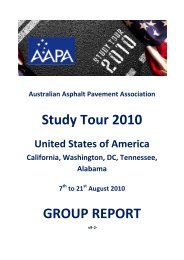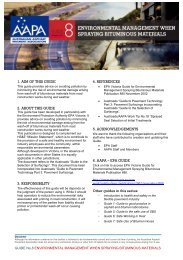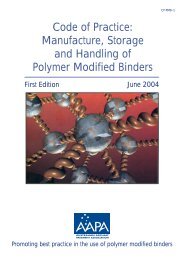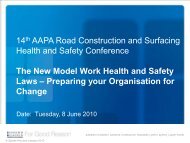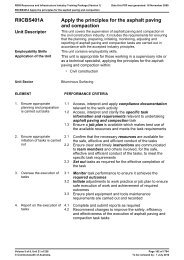Asphalt Review - Feb/March 2013 - Australian Asphalt Pavement ...
Asphalt Review - Feb/March 2013 - Australian Asphalt Pavement ...
Asphalt Review - Feb/March 2013 - Australian Asphalt Pavement ...
Create successful ePaper yourself
Turn your PDF publications into a flip-book with our unique Google optimized e-Paper software.
ASPHALT REVIEW<br />
Pilot vehicles<br />
used in NT to<br />
enhance safety<br />
Vehicle Couplings Warning<br />
Every two months, AAPA holds a<br />
teleconference with representatives of<br />
each of its Branch’s Health and Safety<br />
Committees. This hook-up provides an<br />
opportunity for those involved in health and<br />
safety to share information between states.<br />
At the last teleconference, concern<br />
was expressed about the condition of<br />
some of the couplings on vehicles that<br />
enter our worksites.<br />
A visual inspection of some couplings<br />
showed cracks or other failures. It was<br />
also noted that some vehicles did not<br />
have working warning devices to inform<br />
a driver that the handbrake had not been<br />
applied before they left the vehicle.<br />
These comments prompted those<br />
participating in the teleconference<br />
to suggest the condition of vehicles<br />
entering a worksite should be monitored,<br />
particularly for visible defects such as<br />
cracks in couplings and draw bars.<br />
This warming has been sent to<br />
all members of AAPA through its<br />
newsletter. But it is a warning that<br />
everyone involved with heavy vehicles<br />
should be aware of and ensure that they<br />
conduct regular inspections.<br />
Safety is a feature of this edition of Roads/<br />
<strong>Asphalt</strong> <strong>Review</strong>. It is worth highlighting what one<br />
government department is doing to enhance safety.<br />
The Northern Territory Department of<br />
Infrastructure has implemented a requirement<br />
to help protect workers and the passing traffic<br />
adjacent to sealing works. This requires that while<br />
one side of a road is closed for sealing, traffic<br />
passing on the other side must follow a pilot or<br />
escort vehicle.<br />
Sealing sites can be up to four kilometres long and<br />
each site is controlled by three traffic controllers.<br />
One controller operates at each end of the sites<br />
with the third driving the pilot vehicle. The traffic<br />
controllers also take it in turn to drive the vehicle,<br />
providing them with a break from the weather.<br />
Vehicles are usually driven at around 60kph until<br />
they approach the actual work site. They are then<br />
slowed to about 25 kph.<br />
This approach ensures that vehicles all slow to a<br />
safe speed, reducing the risk to those working on<br />
site. It also makes it safer and more comfortable<br />
for the drivers as everyone is required to do the<br />
same speed. All of us have had the experience of an<br />
impatient driver sitting right on our tail wanting to<br />
go faster as we drive at the posted speed limit.<br />
Using pilot vehicles is not new, but it is a great<br />
way of improving safety and should be part of<br />
the worksite safety strategy applied wherever it<br />
is practical.<br />
AAPA/Austroads<br />
Work Tips updated<br />
AAPA and Austroads jointly prepare a range of Work Tips. These<br />
contain practical information for people working in the flexible<br />
pavements industry – they guide workers to help them achieve<br />
the highest standards expected from asphalt and sprayed sealed<br />
pavements.<br />
Work Tips are developed by a joint AAPA/Austroads<br />
committee with input from a wide range of technical experts<br />
across out industry. They are also regularly reviewed to ensure<br />
they remain current.<br />
New and updated Work Tips are then approved by the AAPA<br />
National Technology Committee and by the <strong>Pavement</strong> Task<br />
Force of Austroads.<br />
Once approved Work Tips are made available for free<br />
download from the AAPA website. www.aapa.asn.au.<br />
Two Work Tips have recently been updated and are now<br />
available. These are:<br />
Work Tip 15: <strong>Asphalt</strong> Production Process Control<br />
This Work Tip provides a guide to the application of statistical<br />
process control charts to the production of asphalt.<br />
Work Tip 17: Air Voids in <strong>Asphalt</strong><br />
This Work Tip outlines the influence of air voids on the<br />
performance of dense graded asphalt mixes, and emphasises<br />
the importance of compaction in achieving intended service<br />
properties.<br />
A full list of Work Tips follows:<br />
36 ROADS FEB/MARCH <strong>2013</strong>


